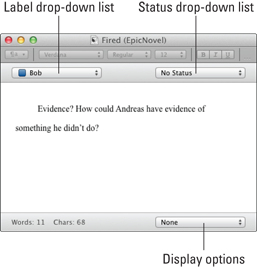Figure 6-13: A QuickReference panel.
Using QuickReference Panels
Want to refer to something, but don’t want to split the Editor to do it (or can’t because you’re in Composition mode)? Or maybe you need to work with more than two documents at the same time.
In either situation, try a QuickReference panel. Just like in split screen, you can edit the content, but the QuickReference panel has some advantages over the split Editor: You can move the QuickReference panel around and resize it, and you can have more than one open at a time.
Here are some easy ways to open a QuickReference panel:
![]() Select one or more documents in the Binder, and then press the spacebar. A QuickReference panel opens for each file selected.
Select one or more documents in the Binder, and then press the spacebar. A QuickReference panel opens for each file selected.
![]() Select the desired document(s) in the Binder, Corkboard, or Outliner, and then click the QuickReference button in the toolbar.
Select the desired document(s) in the Binder, Corkboard, or Outliner, and then click the QuickReference button in the toolbar.
![]() Drag the desired document(s) from the Binder, Corkboard, or Outliner, and then drop it onto the QuickReference button in the toolbar.
Drag the desired document(s) from the Binder, Corkboard, or Outliner, and then drop it onto the QuickReference button in the toolbar.
This method allows you to open a QuickReference panel without changing the Binder selection because you don’t need to select the file before dragging it onto the toolbar button. Also, you can still use this option with a multiple selection, if desired.
![]() Choose View⇒QuickReference and navigate to the desired document in the submenu that appears.
Choose View⇒QuickReference and navigate to the desired document in the submenu that appears.
You can access QuickReference panels via this method in Composition (Full Screen) mode, but you must open each QuickReference panel one at a time if you want to use more than one.
If you already have QuickReference panels open, they stay open and are accessible when you enter Composition (Full Screen) mode.
When you open a QuickReference panel, it stays visible only as long as it’s the active window. After you click in the Editor — or somewhere else within the Scrivener interface — the QuickReference panel hides behind the active window.
To view a QuickReference panel again, choose Window⇒QuickReference Panels, and then choose the desired panel to view from the submenu that appears. Choose Window⇒Float QuickReference Panels to allow the windows to remain visible while you work in the Editor or when you enter Composition (Full Screen) mode.
Within the QuickReference panel, you have access to the Label and Status metadata fields. You also can access other Inspector metadata by using the Display drop-down list at the bottom of the panel. Figure 6-13 shows you the QuickReference panel.


 If you close a QuickReference panel during the current session, you can quickly access it again by choosing Window⇒Closed QuickReference Panels and choosing the document from the submenu that appears. After you close the Scrivener project, however, the Closed Panels submenu is cleared.
If you close a QuickReference panel during the current session, you can quickly access it again by choosing Window⇒Closed QuickReference Panels and choosing the document from the submenu that appears. After you close the Scrivener project, however, the Closed Panels submenu is cleared.